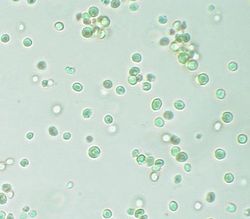| Eustigmatophyte | |
|---|---|
 | |
| Nannochloropsis sp. | |
| Scientific classification | |
| Domain: | Eukaryota |
| Clade: | Sar |
| Clade: | Stramenopiles |
| Phylum: | Ochrophyta |
| Clade: | Chrysista |
| Superclass: | Limnistia |
| Class: | Eustigmatophyceae Hibberd & Leedale, 1971 |
| Orders | |

Eustigmatophytes are a small group (17 genera; ~107 species) of eukaryotic forms of algae that includes marine, freshwater and soil-living species. [1] [2]
Contents
All eustigmatophytes are unicellular, with coccoid cells and polysaccharide cell walls. Eustigmatophytes contain one or more yellow-green chloroplasts, which contain chlorophyll a and the accessory pigments violaxanthin and β-carotene. Eustigmatophyte zoids (gametes) possess a single or pair of flagella, originating from the apex of the cell. Unlike other heterokontophytes, eustigmatophyte zoids do not have typical photoreceptive organelles (or eyespots); instead an orange-red eyespot outside a chloroplast is located at the anterior end of the zoid.
Ecologically, eustigmatophytes occur as photosynthetic autotrophs across a range of systems. Most eustigmatophyte genera live in freshwater or in soil, although Nannochloropsis contains marine species of picophytoplankton (2–4 μm).
The class was erected to include some algae previously classified in the Xanthophyceae. [3]